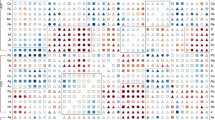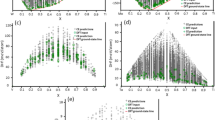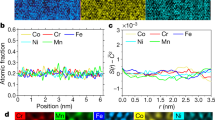Abstract
Any thermodynamically stable or metastable phase corresponds to a local minimum of a potentially very complicated energy landscape. But however complex the crystal might be, this energy landscape is of parabolic shape near its minima. Roughly speaking, the depth of this energy well with respect to some reference level determines the thermodynamic stability of the system, and the steepness of the parabola near its minimum determines the system’s elastic properties. Although changing alloying elements and their concentrations in a given material to enhance certain properties dates back to the Bronze Age1,2, the systematic search for desirable properties in metastable atomic configurations at a fixed stoichiometry is a very recent tool in materials design3. Here we demonstrate, using first-principles studies of four binary alloy systems, that the elastic properties of face-centred-cubic intermetallic compounds obey certain rules. We reach two conclusions based on calculations on a huge subset of the face-centred-cubic configuration space. First, the stiffness and the heat of formation are negatively correlated with a nearly constant Spearman correlation4 for all concentrations. Second, the averaged stiffness of metastable configurations at a fixed concentration decays linearly with their distance to the ground-state line (the phase diagram of an alloy at zero Kelvin). We hope that our methods will help to simplify the quest for new materials with optimal properties from the vast configuration space available.
This is a preview of subscription content, access via your institution
Access options
Subscribe to this journal
Receive 51 print issues and online access
$199.00 per year
only $3.90 per issue
Buy this article
- Purchase on Springer Link
- Instant access to full article PDF
Prices may be subject to local taxes which are calculated during checkout

 and
and  for the correlation between stiffness
for the correlation between stiffness  and enthalpy excess β.
and enthalpy excess β.
 as a function of the enthalpy excess β before averaging over all structures at constant β.
as a function of the enthalpy excess β before averaging over all structures at constant β.

Similar content being viewed by others
References
Craddock, P. T. The composition of the copper alloys used by the Greek, Etruscan and Roman Civilisations. 1. The Greeks before the Archaic period. J. Archaeol. Sci. 3, 93–113 (1976)
Craddock, P. T. The composition of the copper alloys used by the Greek, Etruscan and Roman civilisations: 2. The Archaic, Classical and Hellenistic Greeks. J. Archaeol. Sci. 4, 103–123 (1977)
Yuge, K. Prediction of superhard cubic boron-carbon nitride through first principles. J. Phys. Condens. Matter 21, 415403 (2009)
Spearman, C. The proof and measurement of association between two things. Am. J. Psychol. 15, 72–101 (1904)
Wertime, T. A. The beginnings of metallurgy: a new look. Science 182, 875–887 (1973)
Raabe, D. et al. Theory-guided bottom-up design of β-titanium alloys as biomaterials based on first principles calculations: theory and experiments. Acta Mater. 55, 4475–4487 (2007)
Saito, T. et al. Multifunctional alloys obtained via a dislocation-free plastic deformation mechanism. Science 300, 464–467 (2003)
Holec, D., Friák, M., Dlouhy, A., l & Neugebauer, J. Ab initio study of pressure stabilized NiTi allotropes: pressure-induced transformations and hysteresis loops. Phys. Rev. B 84, 224119 (2012)
Hart, G. L. W. & Forcade, R. W. Algorithm for generating derivative structures. Phys. Rev. B 77, 224115 (2008)
Hart, G. L. W. Where are nature’s missing structures? Nature Mater. 6, 941–945 (2007)
Kresse, G. & Furthmüller, J. Efficient iterative schemes for ab initio total-energy calculations using a plane-wave basis set. Phys. Rev. B 54, 11169–11186 (1996)
Kresse, G. & Furthmüller, J. Efficiency of ab-initio total energy calculations for metals and semiconductors using a plane-wave basis set. Comput. Mater. Sci. 6, 15–50 (1996)
Lerch, D. et al. UNCLE: a code for constructing cluster expansions for arbitrary lattices with minimal user-input. Model. Simul. Mater. Sci. Eng. 17, 055003 (2009)
Sanchez, J. M. & de Fontaine, D. in Structure and Bonding in Crystals Vol. 2 117 (Academic, 1981)
Sanchez, J. M., Ducastelle, F. & Gratias, D. Generalized cluster expansion of multicomponent systems. Physica A 128, 334–350 (1984)
Liu, J. Z., van de Walle, A., Ghosh, G. & Asta, M. Structure, energetics, and mechanical stability of Fe-Cu bcc alloys from first-principles calculations. Phys. Rev. B 72, 144109 (2005)
Zhu, L.-F. et al. First-principles study of the thermodynamic and elastic properties of eutectic FeTi alloys. Acta Mater. 60, 1594–1602 (2012)
Duan, G. et al. Strong configurational dependence of elastic properties for a binary model metallic glass. Appl. Phys. Lett. 89, 151901 (2006)
Blum, V., Hart, G. L. W., Walorski, M. J. & Zunger, A. Using genetic algorithms to map first-principles results to model Hamiltonians: application to the generalized Ising model for alloys. Phys. Rev. B 72, 165113 (2005)
Hart, G. L. W., Blum, V., Walorski, M. J. & Zunger, A. Evolutionary approach for determining first-principles hamiltonians. Nature Mater. 4, 391–394 (2005)
Perdew, J. P., Burke, K. & Ernzerhof, M. Generalized gradient approximation made simple. Phys. Rev. Lett. 77, 3865–3868 (1996)
Blöchl, P. E. Projector augmented-wave method. Phys. Rev. B 50, 17953–17979 (1994)
Methfessel, M. & Paxton, A. T. High-precision sampling for Brillouin-zone integration in metals. Phys. Rev. B 40, 3616–3621 (1989)
Blöchl, P. E., Jepsen, O. & Andersen, O. K. Improved tetrahedron method for Brillouin-zone integrations. Phys. Rev. B 49, 16223–16233 (1994)
Zhou, Y. et al. First-principles studies of Ni-Ta intermetallic compounds. J. Solid State Chem. 187, 211–218 (2012)
Acknowledgements
Funding by the DFG (Deutsche Forschungsgemeinschaft) grant Mu1648/5 is acknowledged. We also thank the RRZ-Hamburg super-computing site for a generous amount of computational time and E. Kahnert and her team for support and advice related to the computing facilities. Additional computing resources from the German super-computing alliance HLRN are acknowledged.
Author information
Authors and Affiliations
Contributions
S.B.M. performed the density functional theory calculations for the NiW, NiTa and CuAl alloys, and M.H. for the NiAl alloy. S.B.M. calculated the cluster expansion Hamiltonians, performed the data post processing and wrote the paper. S.M. formulated the original problem and supervised the investigation. All authors participated in the manuscript preparation during all stages of the process.
Corresponding author
Ethics declarations
Competing interests
The authors declare no competing financial interests.
Supplementary information
Supplementary Figures
This file contains additional ground-state diagrams. (PDF 6916 kb)
Rights and permissions
About this article
Cite this article
Maisel, S., Höfler, M. & Müller, S. A canonical stability–elasticity relationship verified for one million face-centred-cubic structures. Nature 491, 740–743 (2012). https://doi.org/10.1038/nature11609
Received:
Accepted:
Published:
Issue Date:
DOI: https://doi.org/10.1038/nature11609
This article is cited by
-
Elemental partitioning and corrosion resistance of Ni–Cr alloys revealed by accurate ab-initio thermodynamic and electrochemical calculations
npj Materials Degradation (2023)
-
Hidden electronic rule in the “cluster-plus-glue-atom” model
Scientific Reports (2016)
-
Substitution with vision
Nature (2012)
Comments
By submitting a comment you agree to abide by our Terms and Community Guidelines. If you find something abusive or that does not comply with our terms or guidelines please flag it as inappropriate.



